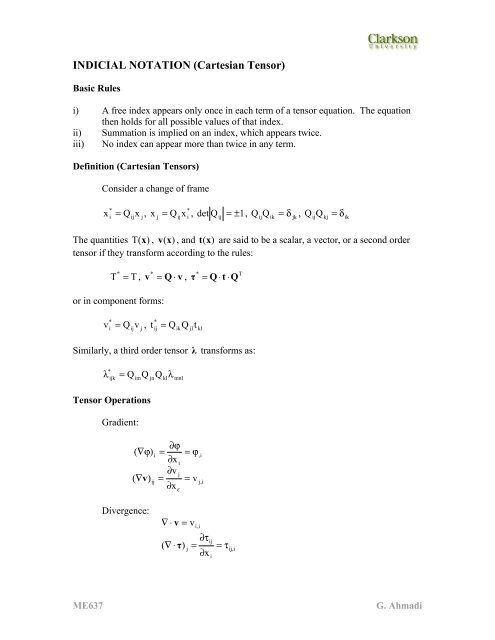INDICIAL NOTATION (Cartesian Tensor)
INDICIAL NOTATION (Cartesian Tensor)
INDICIAL NOTATION (Cartesian Tensor)
Create successful ePaper yourself
Turn your PDF publications into a flip-book with our unique Google optimized e-Paper software.
<strong>INDICIAL</strong> <strong>NOTATION</strong> (<strong>Cartesian</strong> <strong>Tensor</strong>)<br />
Basic Rules<br />
i) A free index appears only once in each term of a tensor equation. The equation<br />
then holds for all possible values of that index.<br />
ii) Summation is implied on an index, which appears twice.<br />
iii) No index can appear more than twice in any term.<br />
Definition (<strong>Cartesian</strong> <strong>Tensor</strong>s)<br />
Consider a change of frame<br />
x = Q x ,<br />
*<br />
i<br />
ij<br />
j<br />
*<br />
x<br />
j<br />
= Qijx<br />
i<br />
, det Qij = ± 1, QijQ ik<br />
= δ<br />
jk<br />
, QijQ kj<br />
= δik<br />
The quantities T(<br />
x ) , v (x)<br />
, and t (x)<br />
are said to be a scalar, a vector, or a second order<br />
tensor if they transform according to the rules:<br />
T * *<br />
= T, v = Q ⋅ v ,<br />
or in component forms:<br />
τ<br />
*<br />
= Q ⋅ t ⋅Q<br />
T<br />
*<br />
*<br />
v<br />
i<br />
= Qijv<br />
j<br />
, t<br />
ij<br />
= QikQ<br />
jlt<br />
kl<br />
Similarly, a third order tensor λ transforms as:<br />
λ<br />
*<br />
ijk<br />
= Q Q Q λ<br />
im<br />
jn<br />
kl<br />
mnl<br />
<strong>Tensor</strong> Operations<br />
Gradient:<br />
∂ϕ<br />
( ∇ϕ)<br />
i<br />
= = ϕ<br />
∂x<br />
i<br />
∂v<br />
j<br />
( ∇v)<br />
ij<br />
= = v<br />
∂x<br />
ε<br />
,i<br />
j,i<br />
Divergence:<br />
∇ ⋅ v = v i,i<br />
∂τij<br />
( ∇ ⋅ τ )<br />
j<br />
= = τ<br />
∂x<br />
i<br />
ij,i<br />
ME637<br />
G. Ahmadi
Curl:<br />
∂U<br />
k<br />
( ∇ × U )<br />
i<br />
= εijk<br />
= εijk<br />
∂x<br />
j<br />
Here, ε<br />
ijk<br />
is the permutation symbol. The permutation symbol is used for<br />
evaluating the determinant. e.g.,<br />
det A = ε A A A ,<br />
ijk<br />
1i<br />
2 j<br />
3k<br />
U<br />
k, j<br />
The inner product of the permutation symbol satisfy the following identity:<br />
ε<br />
ijk<br />
ε<br />
imn<br />
= δ<br />
jm<br />
δ<br />
kn<br />
− δ<br />
jn<br />
δ<br />
km<br />
Laplacian:<br />
Isotropic <strong>Tensor</strong>s<br />
2<br />
2 ∂ ϕ<br />
∇ ϕ =<br />
∂x<br />
∂x<br />
i<br />
i<br />
= ϕ<br />
,ii<br />
Isotropic tensors are tensors, which are form invariant under all possible rotations<br />
of the frame of reference. The most general forms of the isotropic tensors are:<br />
Rank zero: All scalars isotropic<br />
Rank one: None<br />
Rank two: αδ<br />
ij<br />
, α a scalar and δ<br />
ij<br />
= Kronecker delta<br />
Rank three: αε<br />
ijk<br />
Rank four: αδ δ + β δ δ + δ δ ) + γ(<br />
δ δ − δ δ )<br />
ij<br />
kl<br />
(<br />
ik jl il jk ik jl il jk<br />
ME637<br />
G. Ahmadi

















